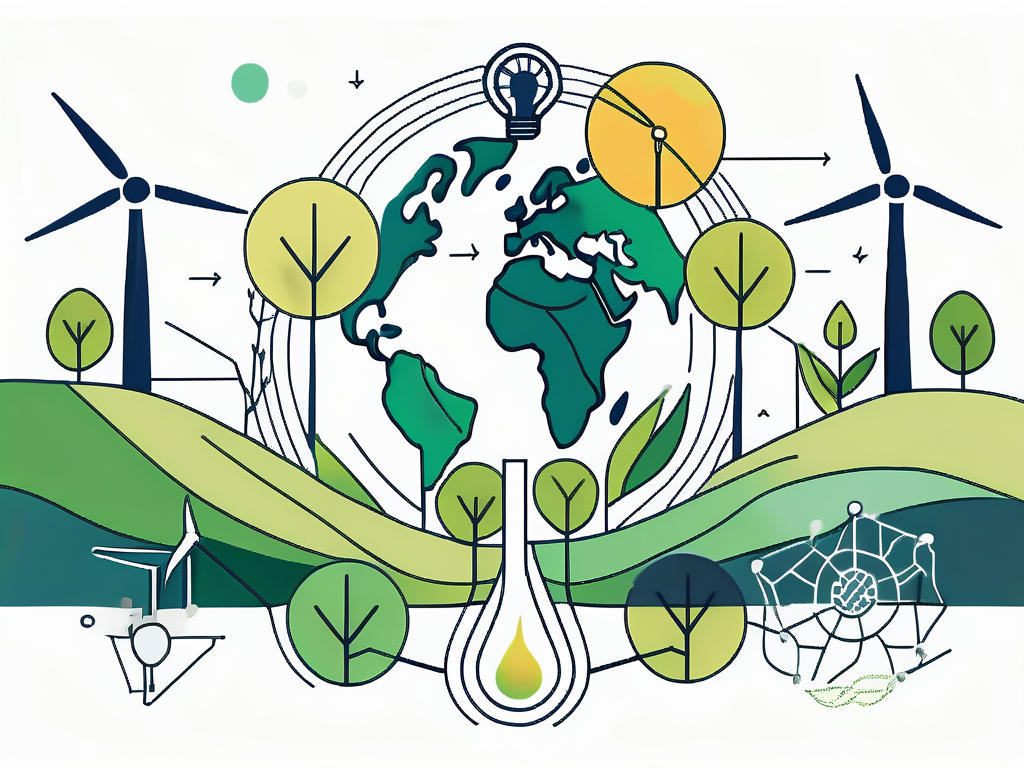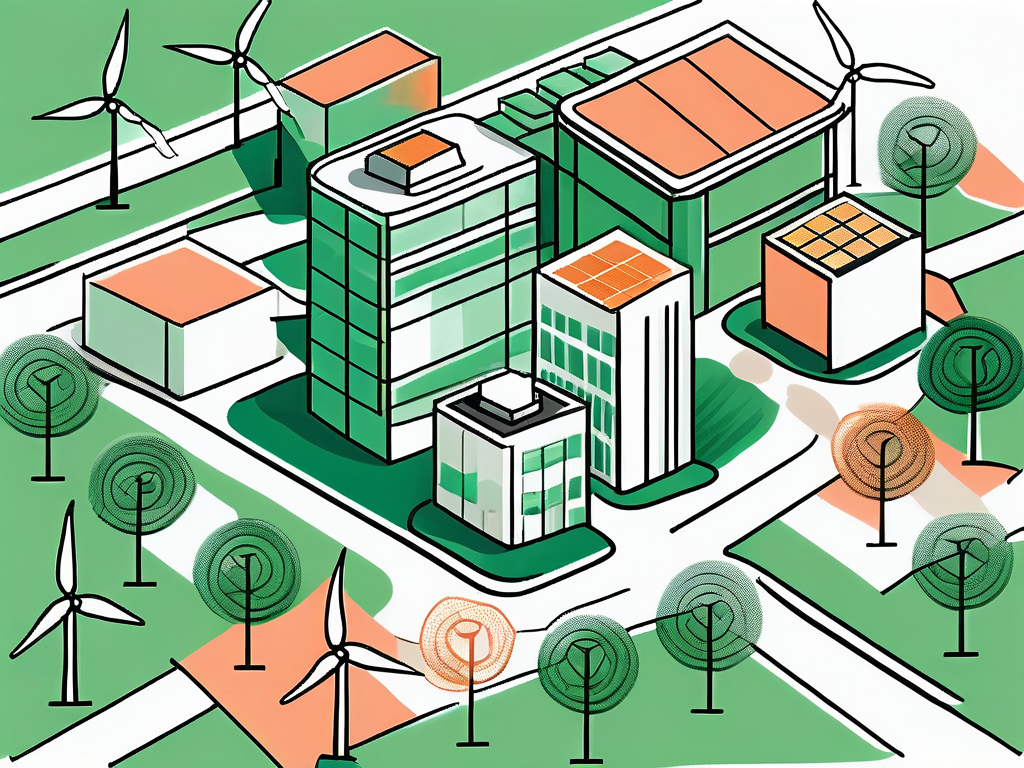
How Businesses Can Achieve Resource-Positive Futures
In today's world, businesses are facing increasing pressure to adopt sustainable practices and reduce their environmental impact. It is no longer enough for companies to simply strive for sustainability - the goal now is to achieve resource-positivity. This concept goes beyond merely minimizing harm; it involves actively contributing to the regeneration and restoration of our planet's resources. In this article, we will explore the concept of resource-positivity, understand its core principles, and delve into the urgency for businesses to embrace this mindset.
The Concept of Resource-Positivity Explained
Resource-positivity is a revolutionary approach to business that seeks to go beyond traditional sustainability practices. It aims to create a net positive impact on the environment and society. This means that businesses actively work towards restoring and regenerating the resources they use, rather than simply reducing their consumption or emissions.

Resource-positivity is not just a buzzword; it represents a fundamental shift in how businesses operate in the modern world. By adopting this approach, companies can not only mitigate their negative impact on the environment but also contribute positively to the ecosystems they are a part of. This proactive stance is essential in the face of increasing environmental challenges and the urgent need for sustainable solutions.
Understanding the Core Principles of Resource-Positivity
At its core, resource-positivity is guided by three key principles. Firstly, it involves shifting from a linear to a circular economy, where waste is minimized and resources are continuously used and reused. Secondly, it emphasizes the importance of regenerating and restoring natural resources, such as clean water, fertile soil, and biodiversity. Finally, resource-positivity involves embracing renewable energy sources and reducing reliance on finite fossil fuels.
These principles are interconnected and form the foundation of a holistic approach to business that considers not just short-term profits but long-term sustainability and resilience. By aligning their operations with these principles, companies can position themselves as leaders in the transition towards a more sustainable and regenerative economy.
The Environmental Impact of Resource-Positivity
By embracing resource-positivity, businesses can significantly reduce their environmental impact. For example, adopting circular economy principles can minimize waste generation and reduce the demand for raw materials. Additionally, regenerative practices can help restore ecosystems and preserve biodiversity, which is crucial for maintaining the health and balance of our planet's natural systems.
The environmental benefits of resource-positivity extend beyond individual businesses to the broader community and ecosystem. By setting a positive example and collaborating with stakeholders, resource-positive companies can drive systemic change towards a more sustainable future. This ripple effect can lead to a collective effort to address pressing environmental issues and create a more harmonious relationship between business activities and the natural world.
The Urgency of Embracing Resource-Positivity
While the concept of resource-positivity may seem ambitious, it is imperative that businesses embrace it with urgency. The consequences of inaction are dire, as the depletion of resources and the effects of climate change continue to accelerate. Fortunately, transitioning to a resource-positive model offers numerous benefits for businesses.

In today's rapidly evolving business landscape, the shift towards resource-positivity is not just a choice but a necessity. As the global population grows and consumption patterns change, the demand for finite resources is reaching unsustainable levels. Embracing resource-positivity is not only a moral imperative but also a strategic advantage for businesses looking to secure their long-term viability in a world facing environmental challenges.
Benefits of Transitioning to a Resource-Positive Model
By adopting resource-positivity, businesses can enhance their brand reputation and differentiate themselves in a crowded market. Consumers are increasingly conscious of the environmental impact of the products they purchase, and are more likely to support businesses that demonstrate a commitment to sustainability. Moreover, resource-positivity can drive innovation and lead to the development of new products and services that are both environmentally friendly and financially lucrative.
Furthermore, transitioning to a resource-positive model can also result in cost savings for businesses in the long run. By reducing waste, optimizing resource use, and implementing sustainable practices, companies can lower their operational expenses and improve their bottom line. This shift towards resource efficiency not only benefits the environment but also contributes to the overall financial health and resilience of the business.
The Role of Innovation in Achieving Resource-Positivity
Innovation plays a crucial role in achieving resource-positivity. Businesses need to continually explore new technologies and processes that enable them to operate more sustainably. This includes investing in renewable energy sources, developing eco-friendly materials, and implementing circular supply chains. By embracing innovation, businesses can unlock new opportunities and stay ahead in an increasingly resource-constrained world.
Moreover, innovation in the context of resource-positivity is not limited to technological advancements. It also encompasses a shift in mindset and organizational culture towards sustainability. Encouraging creativity and out-of-the-box thinking within the workforce can lead to groundbreaking solutions that minimize resource consumption and maximize efficiency. By fostering a culture of innovation, businesses can create a ripple effect that extends beyond their operations, inspiring industry-wide change towards a more sustainable future.
Strategies for Large Corporations to Achieve Resource-Positivity
Large corporations have a unique role to play in driving the transition towards resource-positivity. They possess the scale and resources necessary to make a significant impact. However, implementing resource-positive strategies can be challenging. Therefore, it is essential for these corporations to develop comprehensive plans that address both internal and external factors.

One key aspect of achieving resource-positivity for large corporations is the need to consider the entire value chain of their products and services. This involves not only looking at their direct operations but also assessing the environmental and social impact of their suppliers, distributors, and end-users. By taking a holistic approach to sustainability, corporations can identify opportunities for improvement across the entire value network.
Implementing Sustainable Practices in Corporate Settings
Large corporations can start by implementing sustainable practices within their own operations. This includes setting ambitious targets for emissions reduction, waste minimization, and water conservation. By leading by example, corporations can inspire their employees and stakeholders to embrace resource-positivity.
Furthermore, investing in research and development to innovate new sustainable technologies and practices can also help large corporations achieve resource-positivity. By fostering a culture of innovation and continuous improvement, companies can stay ahead of the curve and drive positive change in their industries.
Overcoming Challenges on the Path to Resource-Positivity
Transitioning to a resource-positive model can present various challenges for businesses. These may include financial barriers, regulatory obstacles, and resistance to change. However, these challenges can be overcome through collaboration and strategic partnerships. By joining forces with other businesses, governments, and non-profit organizations, corporations can leverage collective expertise and resources to overcome barriers and drive meaningful change.
Moreover, engaging with stakeholders, including customers, investors, and local communities, is crucial for large corporations on the path to resource-positivity. By fostering open communication and transparency, companies can build trust and support for their sustainability initiatives, ultimately creating a more resilient and responsible business ecosystem.
Unlocking the Business Benefits of Resource-Positivity
Embracing resource-positivity offers numerous benefits for businesses, extending beyond environmental impact.
Enhancing Brand Reputation Through Resource-Positivity
Consumers today have become increasingly conscious of the brands they support. They are more likely to choose companies that align with their values, such as those committed to sustainability and resource-positivity. By adopting resource-positivity, businesses can enhance their brand reputation and build stronger relationships with their customers.
Imagine a scenario where a consumer is faced with two options for a product they need. One option is a company that has a reputation for wasteful practices and disregard for the environment. The other option is a company that actively promotes resource-positivity and sustainable practices. In this situation, the consumer is more likely to choose the latter, as they feel a sense of alignment with the company's values.
Furthermore, by embracing resource-positivity, businesses can differentiate themselves from their competitors. In a crowded marketplace, where products and services often seem interchangeable, having a strong brand reputation can be a key factor in attracting and retaining customers. By demonstrating a commitment to resource-positivity, businesses can stand out and build a loyal customer base.
Financial Incentives of Embracing Resource-Positivity
Contrary to popular belief, resource-positivity can also bring financial benefits to businesses. By reducing waste and optimizing resource use, companies can lower operational costs. This can be achieved through various strategies, such as implementing energy-efficient technologies, recycling programs, and supply chain optimization.
Let's consider the example of a manufacturing company that adopts resource-positive practices. By implementing energy-efficient machinery and optimizing production processes, they can significantly reduce their energy consumption and associated costs. Additionally, by implementing recycling programs for materials that were previously considered waste, they can reduce their waste disposal expenses. These cost savings can have a direct impact on the company's bottom line and contribute to increased profitability.
Moreover, sustainable practices can lead to increased efficiency and innovation within a business. When companies prioritize resource-positivity, they are forced to critically evaluate their processes and identify areas for improvement. This can result in the development of innovative solutions that not only reduce environmental impact but also drive revenue growth. For example, a company that adopts sustainable packaging practices may attract environmentally-conscious consumers, leading to increased sales and market share.
In conclusion, it is clear that resource-positivity is not merely an aspirational goal, but a necessary mindset for businesses in the 21st century. By adopting resource-positive practices, businesses can minimize their environmental impact, enhance brand reputation, unlock financial benefits, and contribute to the restoration and regeneration of our planet's resources. The time to act is now - let us work together to create a future where businesses thrive while leaving a positive impact on our planet.
Take the Next Step Towards Resource-Positivity with Responsibly
Ready to transform your business into a force for positive change? Responsibly is here to guide you on your journey to resource-positivity. Our AI-driven platform offers comprehensive sustainability due diligence, helping you understand and enhance the sustainability of your suppliers and supply chain. From human rights to decarbonisation, our tailored risk assessments and in-depth supplier insights empower you to make informed decisions for sustainable procurement, risk management, and ESG reporting. Don't wait to make a difference. Book a demo today and start building a future where your business leads the way in sustainability.

